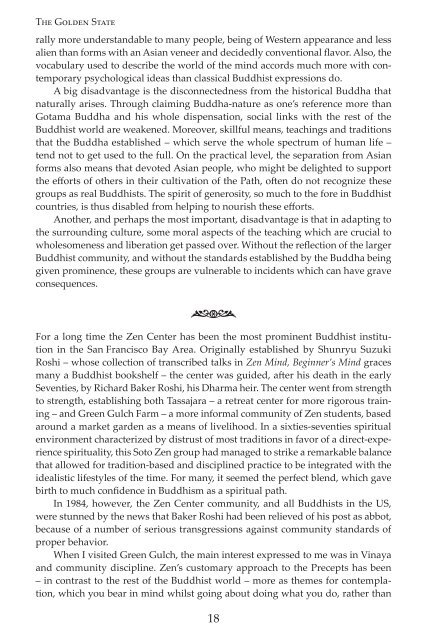Rugged Interdependency - Amaravati Buddhist Monastery
Rugged Interdependency - Amaravati Buddhist Monastery
Rugged Interdependency - Amaravati Buddhist Monastery
- No tags were found...
You also want an ePaper? Increase the reach of your titles
YUMPU automatically turns print PDFs into web optimized ePapers that Google loves.
The Golden Staterally more understandable to many people, being of Western appearance and lessalien than forms with an Asian veneer and decidedly conventional flavor. Also, thevocabulary used to describe the world of the mind accords much more with contemporarypsychological ideas than classical <strong>Buddhist</strong> expressions do.A big disadvantage is the disconnectedness from the historical Buddha thatnaturally arises. Through claiming Buddha-nature as one’s reference more thanGotama Buddha and his whole dispensation, social links with the rest of the<strong>Buddhist</strong> world are weakened. Moreover, skillful means, teachings and traditionsthat the Buddha established – which serve the whole spectrum of human life –tend not to get used to the full. On the practical level, the separation from Asianforms also means that devoted Asian people, who might be delighted to supportthe efforts of others in their cultivation of the Path, often do not recognize thesegroups as real <strong>Buddhist</strong>s. The spirit of generosity, so much to the fore in <strong>Buddhist</strong>countries, is thus disabled from helping to nourish these efforts.Another, and perhaps the most important, disadvantage is that in adapting tothe surrounding culture, some moral aspects of the teaching which are crucial towholesomeness and liberation get passed over. Without the reflection of the larger<strong>Buddhist</strong> community, and without the standards established by the Buddha beinggiven prominence, these groups are vulnerable to incidents which can have graveconsequences.•For a long time the Zen Center has been the most prominent <strong>Buddhist</strong> institutionin the San Francisco Bay Area. Originally established by Shunryu SuzukiRoshi – whose collection of transcribed talks in Zen Mind, Beginner’s Mind gracesmany a <strong>Buddhist</strong> bookshelf – the center was guided, after his death in the earlySeventies, by Richard Baker Roshi, his Dharma heir. The center went from strengthto strength, establishing both Tassajara – a retreat center for more rigorous training– and Green Gulch Farm – a more informal community of Zen students, basedaround a market garden as a means of livelihood. In a sixties-seventies spiritualenvironment characterized by distrust of most traditions in favor of a direct-experiencespirituality, this Soto Zen group had managed to strike a remarkable balancethat allowed for tradition-based and disciplined practice to be integrated with theidealistic lifestyles of the time. For many, it seemed the perfect blend, which gavebirth to much confidence in Buddhism as a spiritual path.In 1984, however, the Zen Center community, and all <strong>Buddhist</strong>s in the US,were stunned by the news that Baker Roshi had been relieved of his post as abbot,because of a number of serious transgressions against community standards ofproper behavior.When I visited Green Gulch, the main interest expressed to me was in Vinayaand community discipline. Zen’s customary approach to the Precepts has been– in contrast to the rest of the <strong>Buddhist</strong> world – more as themes for contemplation,which you bear in mind whilst going about doing what you do, rather than18
















